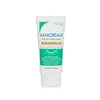What's inside
What's inside
 Key Ingredients
Key Ingredients

 Benefits
Benefits

 Concerns
Concerns

 Ingredients Side-by-side
Ingredients Side-by-side

Zinc Oxide
Cosmetic ColorantWater
Skin ConditioningC12-15 Alkyl Benzoate
AntimicrobialIsopentyldiol
HumectantSqualane
EmollientGlycerin
HumectantCoco-Caprylate/Caprate
EmollientBis-Octyldodecyl Dimer Dilinoleate/Propanediol Copolymer
EmollientGlyceryl Stearate
EmollientPEG-100 Stearate
Polyhydroxystearic Acid
EmulsifyingCetearyl Alcohol
EmollientSucrose Stearate
EmollientCeramide EOP
Skin ConditioningCeramide Ng
Skin ConditioningCeramide NP
Skin ConditioningCeramide As
Skin ConditioningCeramide AP
Skin ConditioningCarnosine
Skin ConditioningPhytosterols
Skin ConditioningHydrogenated Lecithin
EmulsifyingDimethicone
EmollientTriethoxycaprylylsilane
Polyacrylate Crosspolymer-11
Emulsion StabilisingCaprylyl Glycol
Emollient1,2-Hexanediol
Skin ConditioningZinc Oxide, Water, C12-15 Alkyl Benzoate, Isopentyldiol, Squalane, Glycerin, Coco-Caprylate/Caprate, Bis-Octyldodecyl Dimer Dilinoleate/Propanediol Copolymer, Glyceryl Stearate, PEG-100 Stearate, Polyhydroxystearic Acid, Cetearyl Alcohol, Sucrose Stearate, Ceramide EOP, Ceramide Ng, Ceramide NP, Ceramide As, Ceramide AP, Carnosine, Phytosterols, Hydrogenated Lecithin, Dimethicone, Triethoxycaprylylsilane, Polyacrylate Crosspolymer-11, Caprylyl Glycol, 1,2-Hexanediol
Ethylhexyl Methoxycinnamate 5.6%
UV AbsorberOctocrylene 7.5%
UV AbsorberWater 4.8%
Skin ConditioningGlycerin
HumectantDimethicone
EmollientCaprylic/Capric Triglyceride
MaskingC12-15 Alkyl Benzoate
AntimicrobialHydrogenated Lecithin
EmulsifyingCaprylyl Methicone
Skin ConditioningCopaifera Officinalis Resin
MaskingPhenyl Methicone
EmollientEnteromorpha Compressa Extract
Skin ProtectingCaesalpinia Spinosa Gum
Skin ConditioningBisabolol
MaskingAlpha-Arbutin
AntioxidantPhyllanthus Emblica Fruit Extract
HumectantGlycyrrhiza Glabra Root Extract
BleachingCamellia Sinensis Leaf Extract
AntimicrobialChrysanthemum Parthenium Extract
Skin ConditioningHydroxylated Lecithin
EmulsifyingPolysilicone-11
Methicone
EmollientPolyhydroxystearic Acid
EmulsifyingHydroxyethyl Acrylate/Sodium Acryloyldimethyl Taurate Copolymer
Emulsion StabilisingIsohexadecane
EmollientPolysorbate 60
EmulsifyingXanthan Gum
EmulsifyingSodium Benzoate
MaskingPotassium Sorbate
PreservativeGlyceryl Polyacrylate
Citric Acid
BufferingPhenoxyethanol
PreservativeEthylhexyl Methoxycinnamate 5.6%, Octocrylene 7.5%, Water 4.8%, Glycerin, Dimethicone, Caprylic/Capric Triglyceride, C12-15 Alkyl Benzoate, Hydrogenated Lecithin, Caprylyl Methicone, Copaifera Officinalis Resin, Phenyl Methicone, Enteromorpha Compressa Extract, Caesalpinia Spinosa Gum, Bisabolol, Alpha-Arbutin, Phyllanthus Emblica Fruit Extract, Glycyrrhiza Glabra Root Extract, Camellia Sinensis Leaf Extract, Chrysanthemum Parthenium Extract, Hydroxylated Lecithin, Polysilicone-11, Methicone, Polyhydroxystearic Acid, Hydroxyethyl Acrylate/Sodium Acryloyldimethyl Taurate Copolymer, Isohexadecane, Polysorbate 60, Xanthan Gum, Sodium Benzoate, Potassium Sorbate, Glyceryl Polyacrylate, Citric Acid, Phenoxyethanol
 Reviews
Reviews

Ingredients Explained
These ingredients are found in both products.
Ingredients higher up in an ingredient list are typically present in a larger amount.
C12-15 Alkyl Benzoate is made up of Benzoic Acid and long chain alcohols. It has a low molecular weight.
C12-15 Alkyl Benzoate is an emollient and texture enhancer. Due to its solubility, it is often used in sunscreens to help evenly distribute active ingredients.
As an emollient, C12-15 Alkyl Benzoate helps soften and hydrate your skin. Emollients create a film on your skin that traps moisture within.
This ingredient has been reported to cause eye irritation.
Learn more about C12-15 Alkyl BenzoateDimethicone is a type of synthetic silicone created from natural materials such as quartz.
What it does:
Dimethicone comes in different viscosities:
Depending on the viscosity, dimethicone has different properties.
Ingredients lists don't always show which type is used, so we recommend reaching out to the brand if you have questions about the viscosity.
This ingredient is unlikely to cause irritation because it does not get absorbed into skin. However, people with silicone allergies should be careful about using this ingredient.
Note: Dimethicone may contribute to pilling. This is because it is not oil or water soluble, so pilling may occur when layered with products. When mixed with heavy oils in a formula, the outcome is also quite greasy.
Learn more about DimethiconeGlycerin is already naturally found in your skin. It helps moisturize and protect your skin.
A study from 2016 found glycerin to be more effective as a humectant than AHAs and hyaluronic acid.
As a humectant, it helps the skin stay hydrated by pulling moisture to your skin. The low molecular weight of glycerin allows it to pull moisture into the deeper layers of your skin.
Hydrated skin improves your skin barrier; Your skin barrier helps protect against irritants and bacteria.
Glycerin has also been found to have antimicrobial and antiviral properties. Due to these properties, glycerin is often used in wound and burn treatments.
In cosmetics, glycerin is usually derived from plants such as soybean or palm. However, it can also be sourced from animals, such as tallow or animal fat.
This ingredient is organic, colorless, odorless, and non-toxic.
Glycerin is the name for this ingredient in American English. British English uses Glycerol/Glycerine.
Learn more about GlycerinHydrogenated Lecithin is created from the hydrogenation of lecithin (a group of phospholipids). Hydrogenation is a chemical reaction between hydrogen and another element.
This ingredient is an emollient and emulsifier. As an emollient, it helps soften skin by trapping moisture within. As an emulsifier, it prevents oil and water ingredients from separating.
Polyhydroxystearic Acid is a soft wax made from castor oil.
It is is a texture thickener, emulsifier, and film-former. Emulsifiers prevent ingredients from separating, such as oils and waters.
Polyhydroxystearic Acid may not be fungal acne safe.
Learn more about Polyhydroxystearic AcidWater. It's the most common cosmetic ingredient of all. You'll usually see it at the top of ingredient lists, meaning that it makes up the largest part of the product.
So why is it so popular? Water most often acts as a solvent - this means that it helps dissolve other ingredients into the formulation.
You'll also recognize water as that liquid we all need to stay alive. If you see this, drink a glass of water. Stay hydrated!
Learn more about Water